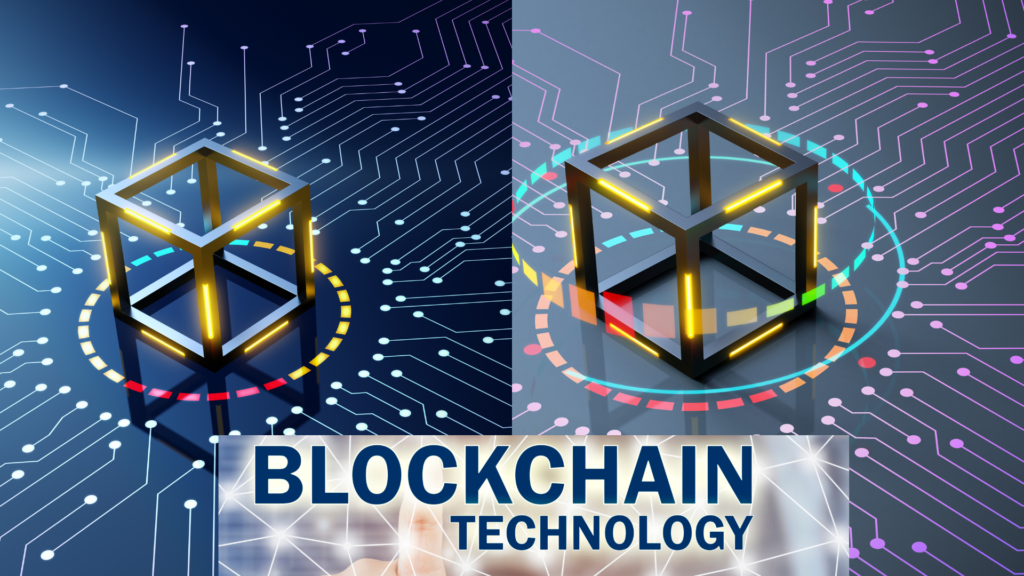FROM HYPE TO REALITY: THE POWER OF BLOCKCHAIN TECHNOLOGY FOR SECURE TRANSACTIONS

Imagine a world where digital transactions are lightning-fast, incredibly secure, and utterly transparent.
Sounds like a dream, right?
Well, the rapid rise of a cutting-edge technology called blockchain is turning that dream into a reality.
While initially surrounded by a tidal wave of hype and speculation, blockchain has since proven its worth as a practical, powerful, and transformative solution for secure transactions in our increasingly digital lives.
Join us on a captivating journey through the world of blockchain as we dive into the topic “From Hype to Reality: The Power of Blockchain Technology for Secure Transactions.”
This blog will guide you through the fascinating principles that underpin this innovative technology, the incredible benefits it brings to the table, and the real-world applications where it’s making a tangible difference.
Blockchain Technology
At its core, blockchain is a decentralized digital ledger that keeps an immutable record of every transaction, making it virtually impossible to tamper with or forge.
This ingenious system has captured the world’s attention and is poised to redefine trust and security in our increasingly digital lives.
In today’s interconnected world, the importance of secure transactions cannot be overstated.
As we rely more and more on digital platforms for our financial, personal, and professional needs, the stakes for ensuring the safety and integrity of our transactions are higher than ever.
Whether you’re shopping online, transferring funds, or sharing sensitive information, the security of your digital interactions is paramount.
For a while, blockchain technology was shrouded in a cloud of hype, with many people touting it as a miracle cure for all of our digital security woes.
But as the dust begins to settle, the true potential of this revolutionary technology is starting to shine through.
No longer just a buzzword or a pipe dream, blockchain is evolving into a practical and powerful solution that’s already making a real impact in the world of secure transactions.
Understanding Blockchain Technology
To truly appreciate the transformative power of blockchain technology, it’s essential to grasp the key concepts and principles that lie at its foundation.
So, let’s dive in and explore these intriguing building blocks that make blockchain such a revolutionary force in the world of secure transactions.
Key concepts and principles
1. Decentralization: One of the most compelling aspects of blockchain technology is its decentralized nature.
Unlike traditional systems that rely on a central authority, such as a bank or a government, blockchain distributes data across a vast network of computers, making it virtually impossible for a single entity to control or manipulate the information.
This decentralization empowers individuals and businesses to transact with one another securely, without the need for intermediaries, fostering a more democratic and resilient digital ecosystem.
It is a type of Distributed Ledger Technology (DLT) which is a digital system for recording transactions or other data across multiple computers or nodes in a decentralized manner.
2. Cryptography: At the heart of blockchain’s unparalleled security lies the art of cryptography.
This advanced mathematical technique encodes data, making it accessible only to those who possess the correct decryption key.
In the context of blockchain, cryptography ensures that transactions are secure, tamper-proof, and verifiable, creating an environment of trust and confidence for all parties involved.
3. Consensus mechanisms: To maintain the integrity and accuracy of the blockchain, a consensus mechanism is employed to validate and confirm transactions.
Various consensus methods exist, such as Proof of Work (used by Bitcoin) or Proof of Stake, each with its own unique approach to achieving consensus among participants in the network.
This ingenious system ensures that only verified transactions are added to the blockchain, maintaining its reliability and security.

The role of blockchain in secure transactions
1. Immutable record-keeping: One of the most powerful features of blockchain technology is its ability to create an immutable record of transactions.
Once a transaction is added to the blockchain, it cannot be altered or removed, providing a permanent, tamper-proof record of all activity.
This feature makes blockchain an ideal solution for secure transactions, as it eliminates the risk of fraud or manipulation.
2. Enhanced transparency: In a blockchain network, every transaction is visible to all participants, fostering a new level of transparency and trust.
This open access to information allows individuals and businesses to verify the legitimacy of transactions and track the flow of assets, building confidence and reducing the likelihood of disputes or misunderstandings.
3. Peer-to-peer transactions: Blockchain technology enables direct, peer-to-peer transactions, cutting out the need for intermediaries such as banks or payment processors.
This streamlined approach not only makes transactions faster and more efficient, but it also reduces costs and increases security, making blockchain an attractive option for secure transactions in a variety of industries and applications.
By combining these innovative concepts and principles, blockchain technology offers a new paradigm for secure transactions, enabling a more transparent, efficient, and resilient digital ecosystem for individuals and businesses alike.
Cryptocurrencies
Cryptocurrencies are an integral component of the journey.
In their early days, cryptocurrencies like Bitcoin and Ethereum garnered significant attention as speculative investments, often fueled by sensational headlines and stories of overnight millionaires.
However, as the technology has evolved and matured, the true potential of cryptocurrency for secure transactions has begun to shine through.
Here’s how cryptocurrencies play a vital role in the power of blockchain technology for secure transactions:
1. Real-world use cases: Beyond their speculative value, cryptocurrencies have started to demonstrate practical applications in various industries.
For instance, they are now being utilized for remittances, online purchases, and even as an alternative form of payment for goods and services at brick-and-mortar establishments.
These real-world use cases exemplify the shift from hype to reality in the context of secure transactions.
2. Enhanced security: Cryptocurrencies leverage the security features inherent to blockchain technology, such as decentralization and cryptography, to provide a more secure alternative to traditional financial transactions.
By reducing the risk of fraud, tampering, and single points of failure, cryptocurrencies contribute to the growing trust in blockchain technology as a practical solution for secure transactions.
3. Financial inclusion: One of the most promising aspects of cryptocurrencies is their potential to promote financial inclusion in underbanked and unbanked populations.
By providing access to secure and efficient financial services without the need for traditional banking infrastructure, cryptocurrencies are helping to bridge the gap between the current financial system and those who have been excluded from it, further emphasizing the shift from hype to reality.
4. Continued innovation: The world of cryptocurrencies is constantly evolving, with new projects and developments emerging regularly.
These innovations, such as improved scalability solutions, privacy enhancements, and novel consensus mechanisms, continue to push the boundaries of what’s possible with blockchain technology for secure transactions, driving the transition from mere hype to tangible real-world applications.

Public Blockchain and Private Blockchain
Public and private blockchains are two distinct types of blockchain networks that cater to different use cases and requirements.
While both share the foundational principles of blockchain technology, such as decentralization, immutability, and the use of cryptography, they differ in terms of access, control, and overall objectives.
Let’s take a closer look at the key differences between public and private blockchains.
Public Blockchain:
1. Access: A public blockchain is open to anyone who wants to participate in the network. Anyone can join, read, write, and validate transactions on a public blockchain, making it truly decentralized and transparent.
2. Security: Public blockchains rely on consensus mechanisms, like Proof of Work (PoW) or Proof of Stake (PoS), to maintain the security and integrity of the network.
These mechanisms help ensure that transactions are verified and validated by multiple nodes, making it difficult for any single participant to manipulate the system.
3. Anonymity: Public blockchains typically offer a degree of anonymity, as participants are identified by their public keys rather than personal information.
However, it’s worth noting that transactions are recorded on a public ledger, which can be analyzed to trace activity back to specific users.
4. Examples: Some well-known examples of public blockchains include Bitcoin, Ethereum, and Litecoin.
These networks are designed for creating and managing cryptocurrencies and facilitating peer-to-peer transactions.
Private Blockchain:
1. Access: A private blockchain, also known as a permissioned blockchain, restricts access to a select group of participants. Only authorized users can join, read, write, or validate transactions on a private blockchain, providing a more controlled and secure environment.
2. Security: Private blockchains still utilize cryptography and consensus mechanisms to maintain security, but the level of decentralization is typically lower than in public blockchains.
This can result in improved efficiency and scalability, but may also create potential vulnerabilities or single points of failure.
3. Privacy: In a private blockchain, transactions are accessible only to authorized participants, offering a higher degree of privacy compared to public blockchains.
This makes private blockchains more suitable for use cases where sensitive information must be protected, such as in financial services or supply chain management.
4. Examples: Examples of private blockchains include Hyperledger Fabric, R3 Corda, and Quorum.
These networks are often used by organizations for specific applications, such as interbank transactions, asset tracking, or data management.
In summary, public blockchains provide an open, decentralized, and transparent platform for various applications, with a focus on security and anonymity.
In contrast, private blockchains offer a more controlled and secure environment, prioritizing privacy and efficiency, making them more suitable for enterprise and specific industry use cases.
Choosing between a public or private blockchain depends on the specific needs and objectives of the project or organization.
Real-world Applications of Blockchain Technology for Secure Transactions
As the power of blockchain technology becomes increasingly apparent, its potential for secure transactions is being harnessed across a wide range of industries and applications.
Let’s explore some of the most intriguing and impactful real-world use cases that are already transforming the way we conduct business and exchange value.
Financial services
1. Cross-border payments: Blockchain is revolutionizing the way we send and receive money across borders, enabling faster, cheaper, and more secure transactions.
By bypassing traditional intermediaries, such as banks and payment processors, blockchain facilitates direct transfers between parties, drastically reducing fees and wait times associated with international transactions.
2. Fraud prevention: The immutable and transparent nature of blockchain makes it an ideal tool for combating fraud in the financial sector.
By creating a permanent, tamper-proof record of transactions, blockchain can help detect and prevent fraudulent activities, such as double-spending or identity theft, ensuring the integrity of financial systems.
3. Smart contracts: Blockchain technology has given rise to a new form of digital agreement known as smart contracts.
These self-executing contracts automatically enforce the terms and conditions of an agreement, streamlining processes and reducing the need for intermediaries.
In the financial sector, smart contracts can be used to facilitate secure loans, automate insurance claims, and much more.
Supply chain management
1. Provenance tracking: Blockchain offers a powerful solution for tracking the origin and movement of goods throughout a supply chain.
By providing a transparent and tamper-proof record of a product’s journey, blockchain technology can help businesses ensure the authenticity and quality of their goods, fostering consumer trust and confidence.
2. Reducing counterfeit goods: Counterfeit products pose a significant threat to businesses and consumers alike.
By utilizing blockchain technology to create a verifiable record of a product’s provenance, businesses can effectively combat counterfeit goods, safeguarding their reputation and protecting consumers.
3. Streamlining logistics: Blockchain technology can be used to improve the efficiency and transparency of logistics processes, such as shipping and customs clearance.
By providing real-time, accessible information on the status and location of shipments, blockchain can help streamline operations and reduce delays, saving time and money for businesses and consumers.
Other industries
1. Healthcare: In the healthcare sector, blockchain technology can be used to secure and streamline the sharing of sensitive patient information, improving the quality and coordination of care while safeguarding privacy.
2. Government services: Blockchain has the potential to transform government services by increasing transparency, reducing bureaucracy, and improving the security and efficiency of processes such as voting, land registry management, and public records storage.
3. Real estate: In the world of real estate, blockchain technology can be used to simplify and secure property transactions, streamlining processes such as title transfers, mortgage approvals, and property searches, while reducing the risk of fraud.
As blockchain technology continues to evolve and mature, its potential for secure transactions is being realized across a diverse range of industries, driving innovation and unlocking new opportunities for growth and progress.

Challenges and Limitations of Blockchain Solution Technology
While blockchain technology has undoubtedly brought about a paradigm shift in secure transactions and boasts numerous promising applications, it’s essential to acknowledge the challenges and limitations that currently surround it.
Let’s delve into some of the key hurdles that must be overcome for blockchain technology to reach its full potential.
1. Scalability issues
One of the most pressing concerns for blockchain technology is its ability to scale effectively.
As the number of users and transactions on a network grows, so does the demand for processing power and storage.
This can lead to slower transaction times and higher fees, making it less attractive for widespread use.
Many projects and initiatives are underway to address these scalability issues, with solutions like sharding, layer-2 technologies, and alternative consensus mechanisms showing promise in enhancing blockchain’s ability to handle increased transaction volumes.
2. Energy consumption concerns
The energy consumption of certain blockchain networks, particularly those using Proof of Work consensus mechanisms like Bitcoin, has sparked widespread debate and concern.
The process of mining, which involves solving complex mathematical problems to validate transactions and maintain the network’s security, can consume vast amounts of electricity.
This has raised questions about the environmental sustainability of some blockchain networks.
To address these concerns, alternative consensus mechanisms, such as Proof of Stake and Delegated Proof of Stake, are being developed and adopted to reduce energy consumption while maintaining network security.
3. Regulatory and legal hurdles
As a relatively new and disruptive technology, blockchain faces numerous regulatory and legal challenges.
Governments and regulatory bodies around the world are grappling with how to develop and enforce rules and guidelines that foster innovation while protecting consumers and businesses.
Issues like taxation, anti-money laundering regulations, and data protection laws must be navigated carefully to ensure that blockchain technology can continue to grow and thrive.
Additionally, the decentralized nature of blockchain presents unique challenges when it comes to jurisdiction and enforcement, requiring a collaborative and forward-thinking approach from policymakers and industry leaders alike.
The Future of Blockchains for Secure Transactions
As we venture further into the digital age, the importance of secure transactions will only continue to grow, and blockchain technology is poised to play a pivotal role in shaping that future.
Let’s explore the exciting developments on the horizon as blockchain technology advances, gains wider adoption, and paves the way for a more secure, transparent, and efficient digital economy.
1. Innovations and improvements in the technology
Blockchain technology is still in its relative infancy, with numerous innovations and improvements expected to emerge in the coming years.
These advancements will likely address existing challenges such as scalability, energy consumption, and privacy concerns, making blockchain even more robust and versatile.
From groundbreaking consensus mechanisms and off-chain solutions to enhanced interoperability between different blockchain networks, the future of blockchain technology promises to be even more dynamic and powerful than it is today.
2. Wider adoption and integration into mainstream systems
As the benefits of blockchain technology become increasingly apparent, we can expect to see wider adoption and integration into mainstream systems and applications.
This will likely extend beyond the realm of finance and supply chains to encompass a diverse array of industries such as healthcare, education, and entertainment.
As more businesses and governments recognize the potential of blockchain to improve efficiency, reduce costs, and increase transparency, we can anticipate a future where blockchain technology is woven into the fabric of our digital lives, transforming the way we transact, communicate, and share information.
3. The role of blockchain in a more secure, transparent, and efficient digital economy
In the years to come, the role of blockchain technology in creating a more secure, transparent, and efficient digital economy cannot be understated.
By enabling tamper-proof record-keeping, enhanced trust, and streamlined peer-to-peer transactions, blockchain technology has the potential to revolutionize how we exchange value and information across borders and industries.
As a result, blockchain will likely play a crucial role in fostering economic growth, driving innovation, and empowering individuals and businesses to transact with confidence and ease.
Final Thoughts on Blockchain Security
We have reached the end of our captivating journey into the world of blockchain technology and secure transactions. It is clear that this ground-breaking innovation holds immense power and potential to revolutionize the way we conduct business and exchange value in the digital age.
From providing unparalleled security and transparency through its decentralized, immutable nature, to streamlining transactions across a wide range of industries such as finance, supply chain management, healthcare, and more, blockchain technology is poised to become a transformative force in our increasingly digital lives.
However, to truly harness the incredible benefits that blockchain has to offer, we must continue to explore, innovate, and adopt this technology on a broader scale.
As we tackle the challenges and limitations that currently surround blockchain, we open the door for even more exciting advancements and applications in the future.
So, let’s embrace the transformative power of blockchain technology for secure transactions and continue to push the boundaries of what’s possible in our digital world.
Together, we can pave the way for a more secure, transparent, and efficient digital economy, unlocking new opportunities for growth, innovation, and empowerment for all.
Empower your start-up or SME with robust cybersecurity! Contact Cyb-Uranus for tailored solutions and expert guidance to secure your digital assets. Act now and build a resilient cybersecurity program with us!

